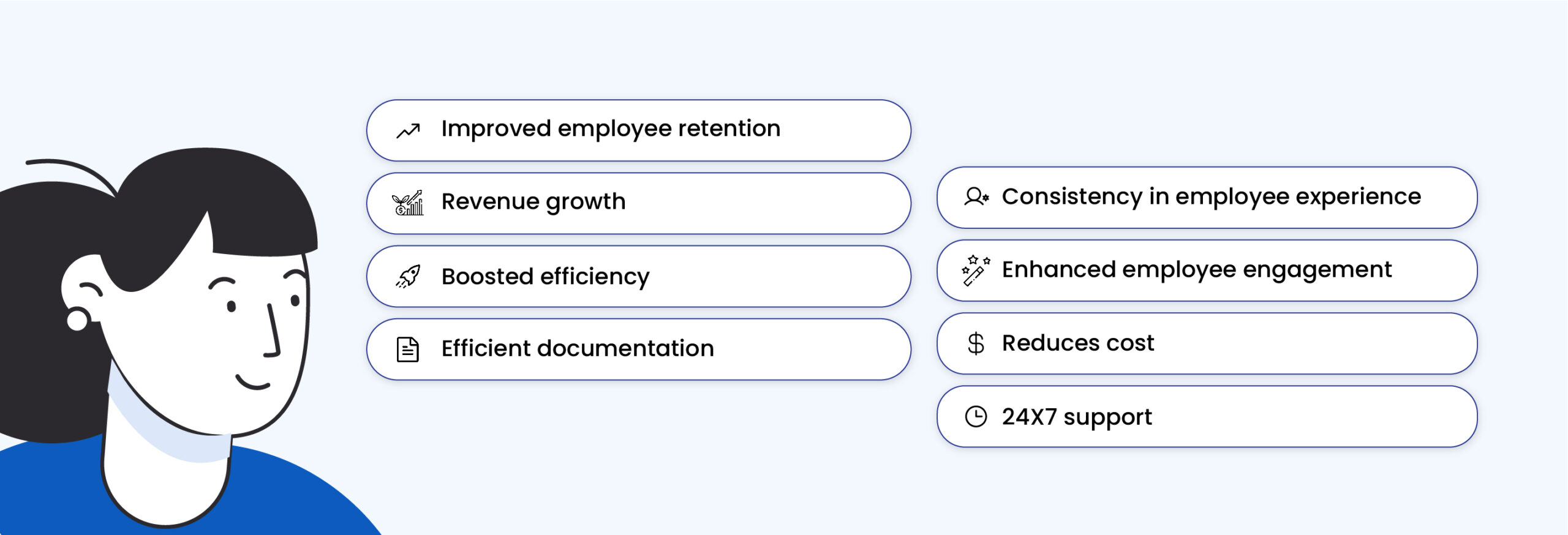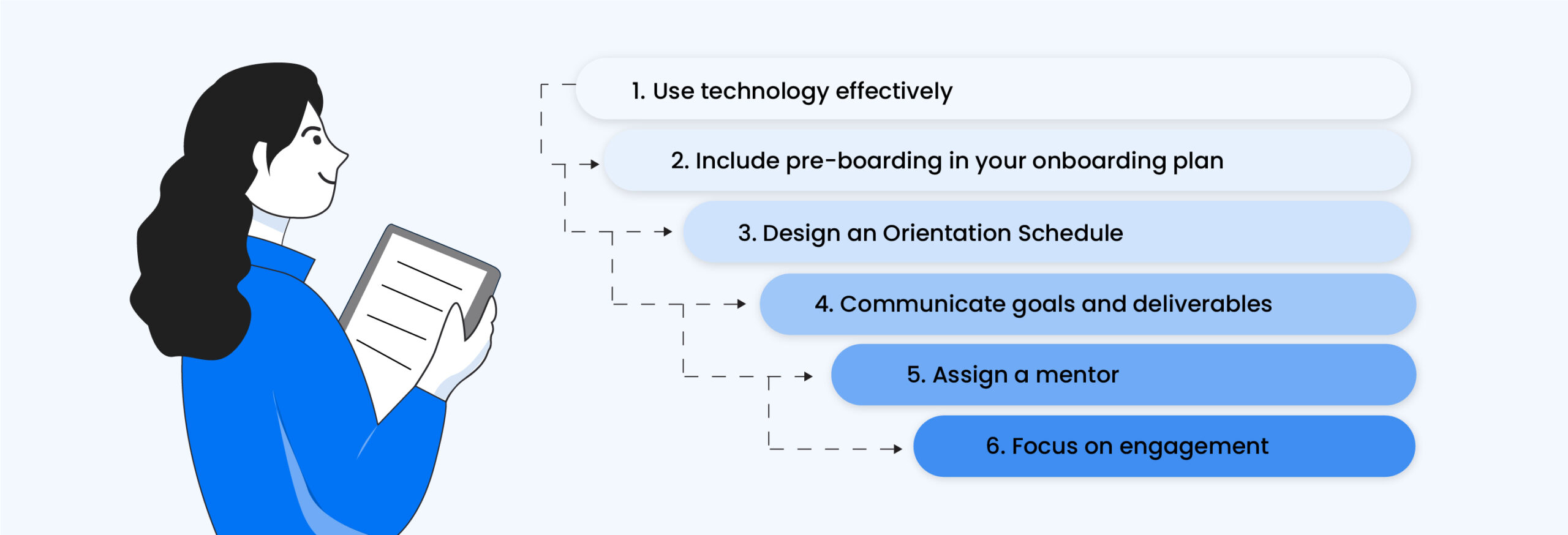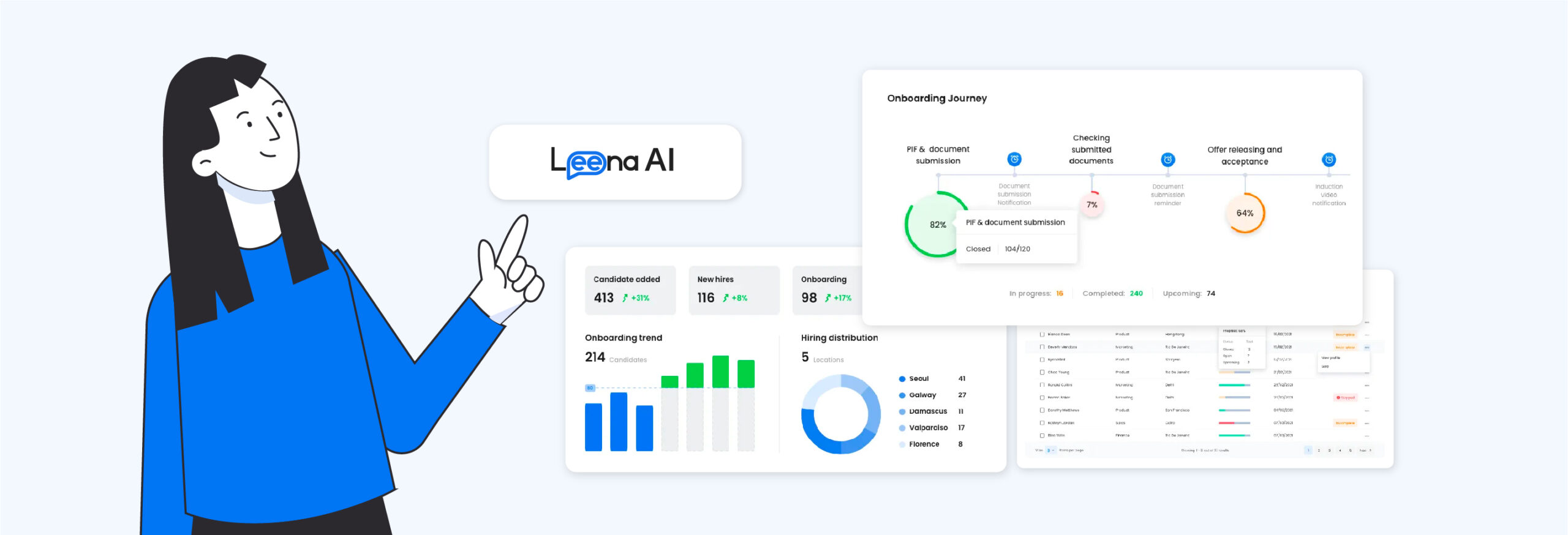Despite being one cornerstone of business success, employee onboarding remains significantly neglected in many companies. According to statistics, over one-third of employers don’t have a thorough, structured onboarding process for new hires.
Poor onboarding is especially problematic in remote and hybrid work models. It translates to weak employee engagement, low productivity, and high turnover.
Some of the most prevalent causes of inefficient onboarding include confusing orientation, overwhelming new hires with information, overlooking pre-boarding activities, poor management, etc.
Read this article to decode how digital employee onboarding can help you reverse your flawed onboarding process through automation and AI-powered technology.
What can organizations do to overcome the onboarding challenges?
The best way to overcome onboarding challenges is to move away from the traditional method of welcoming a new hire and integrate digitalization into the process.
Digital employee onboarding accommodates on-site, remote, and hybrid employees by giving them access to crucial information and providing them support 24*.
The digital onboarding approach brings data-driven intelligent automation into the picture. Thanks to digital employee onboarding software, companies can overcome onboarding challenges through better transaction accuracy, greater control over the workflows, and consistency across departments, be it remote or hybrid work structures.
Benefits of digital employee onboarding

Below mentioned are the benefits of digital employee onboarding.
Improves employee retention
Employee onboarding plays a crucial part in the overall employee experience. According to SHRM, about 50% of employee attrition occurs within 18 months of joining.
This is why a proper onboarding strategy is gaining significant momentum across industries. Reports state that companies with a formal and organized onboarding process have an average employee retention rate of 86%.
Implementing digital practices in the onboarding program makes repetitive but necessary steps automatic and streamlined. New hires can quickly complete paperwork and get all the relevant information whenever they want. This contributes to employee satisfaction, making employees stay longer in their current organization.
Drives revenue growth
The onboarding process is an opportunity to make an excellent first impression. When you make it digital, it streamlines every operation and makes the process easy for both the candidate and the HR department. It lets the company invest time and resources to make new hires feel welcomed and bring a positive employee experience. Such employees are more willing to invest their time and energy into their work.
Apart from that, digital onboarding boosts retention. A business can receive several benefits from employee retention, including better customer service, reduced hiring costs, and optimized employee productivity. All these factors contribute to the increase in departmental and overall company profits.
Boosts efficiency
Manual onboarding can take up much time for the HR department. Traditional onboarding programs require employees to complete colossal paperwork, go through different company policies, participate in surveys, and join training events for hours, sometimes days.
Without digital employee onboarding, the HR department deals with all the data collection and processing, sometimes delaying the process due to errors and mishaps.
When you implement digital employee onboarding software, the repetitive tasks become automated, ensuring proper organization and security of employee information and accuracy in processing data. It makes the process much more efficient by eliminating human intervention in several onboarding tasks.
Ensures efficient documentation
Modern companies are increasingly adopting remote and hybrid work models. Given this, automating the documentation process can be beneficial.
The AI-driven document management system can help new hires complete paperwork through digital signatures, and check whether the documents are valid and if the organizations meet compliance laws.
Provides consistent employee experiences
As shared previously, digital employee onboarding software automates the entire process and makes it streamlined. So, whenever a new hire joins, it provides consistent experiences to the new employees.
Unlike manual employee onboarding, there is no probability of missing out on any critical steps in the onboarding process. Everything runs smoothly.
Enhances employee engagement
Digital employee onboarding can help organizations deliver an engaging experience to new hires. It can save them from getting overwhelmed with long administrative processes and keep them interested from day 1 with interactive training and personalized mentorship.
Integrating technology into the process makes it easier to run frequent employee surveys and boost employee engagement.
Reduces cost
Whether you are onboarding new hires traditionally or digitally, it costs the company significant time and resources. But traditional onboarding includes mountains of paperwork and a considerable amount of printing costs.
Digital employee onboarding eliminates such expenditure without losing process efficiency or compromising the workflow. Implementing technology in onboarding also reduces the need for in-person training, saving the money spent on hiring trainers.
The cost of turnover is also high. According to reports, losing an employee can cost a company 50%–250% of the employee’s annual salary. With a digital employee onboarding experience, you increase retention and save the company the enormous costs of employee attrition.
24X7 support
No matter how thorough your onboarding strategy is, your new employees are still likely to have doubts about how to perform tasks correctly.
With digital employee onboarding, your new hires get instant support through AI-powered conversational virtual assistants without depending on HRs. Such an efficient system allows employees to prioritize learning instead of running around with questions and confusion.
How to create a digital onboarding process?

Digital employee onboarding has many benefits. But a company needs to develop a well-defined onboarding strategy to get the best results.
Each step should be personalized and accommodating to on-site, hybrid, and remote employees. To ensure you don’t miss out on any vital process element, here is a digital employee onboarding checklist you can refer to:
Use technology effectively
Technology is the foundation of digital employee onboarding. Especially in a hybrid or remote work model, your employees must have adequate tools to navigate their duties. You need an efficient one-stop platform that can easily streamline your digital onboarding process accurately without compromising on the regular workflow.
Hence, before you digitize your company’s onboarding process, thoroughly research different HR tools and their features. Then choose the one that aligns with your business needs.
Include preboarding in your onboarding plan
The first day of onboarding involves a significant amount of administrative formalities. To ensure it goes smoothly, adding the preboarding phase to your strategy will ease things up.
In this step, you can complete tasks like setting up email accounts and required access for new hires, shipping their equipment before their joining date, structuring and rechecking training modules, connecting with respective team leaders to ensure they are prepared to welcome new hires, informing different departments on the recruit’s arrival, etc. So, by including these tasks in your preboarding strategy, you can avoid any last-minute mishaps.
Design an orientation schedule
Onboarding is not a one-day affair. Typically, proper onboarding can last up to 90 days. Hence, it is crucial to structure it like a strategic, long-term process coordinated with all levels of the organization. If you are adopting a hybrid or a remote work model, you need to make space for a practical virtual orientation.
To ensure everything goes as planned, developing a detailed schedule for the onboarding process is the best way. Create a schedule for the first week or days with clearly mapped-out agendas. Create a 30-60-90 day plan with as much detail as possible. Involve all members of the leadership while creating the orientation schedule.
Communicate goals and deliverables
A new hire is bound to experience the first-day jitters. They will need clarification about what the company expects from them. The managers should discuss their expectations with the new employees to minimize their stress and ensure productivity from the very first day.
From the beginning, team leaders can provide the recruits with regular tasks, goals, stretch goals, and key performance indicators. You can also create PowerPoint presentations and short videos on common topics, such as completing timesheets, using job-specific software, etc.
Assign a mentor
The new hires may feel intimidated and hesitate to reach out to their superiors with any doubts. To counter this issue, assigning a mentor will make them feel comfortable to ask questions and take help.
The mentor should be from the new employee’s assigned team. Find someone with enough experience to help recruits navigate their way and are friendly enough not to intimidate them. The mentor will check on them, educate them on the company’s vision and policies, and help them perform their daily tasks.
Focus on engagement
Include innovative ways to keep your employees engaged from the very beginning. You can start virtual meetings with a discussion-based question by asking how the recruits handle remote work, what they like most and least about their work setting, or how they want to spend their free time.
You can arrange a casual meet and greet so the new hires can interact and create a bond with their colleagues. You can also quiz new employees about their coworkers and reward them with small gifts to encourage participation. Ensuring new hires get regular feedback on their work is also vital to maintain employee engagement.
Tools that facilitate digital employee onboarding
There is plenty of digital employee onboarding software in the market. But you need an HR tool that simultaneously provides all the required features and is scalable and secure. Here are the seven best employee onboarding tools you can choose from to create the best first impression:
Leena AI
The Leena AI platform is prominent among organizations across different industries due to its user-friendliness, AI-driven capability, customization, and scalability. It is an HR automation software providing a one-stop solution for your digital employee onboarding needs.
Leena AI automates the onboarding process and creates a smooth experience for new hires. It provides an analytics dashboard to let HR leaders gain visibility into employee experience and their pain points.
Leena AI also has an intuitive sentiment analysis feature. Its onboarding surveys, pulse surveys, and superior analytics identify the pain points in real-time and help you improve your onboarding plan. Its virtual assistant quickly answers employees’ queries and deals with their grievances.
Bamboo HR
Bamboo HR is a popular HR software that offers efficient automation and relieves the HR department from handling repetitive tasks. It also tracks the progress of the new hires and provides a centralized database, employee self-service, automated time-off, etc.
Whatfix
Whatfix is a digital HR platform that allows L&D teams to create customized and scalable employee onboarding checklists. It provides guided digital tours to enable new hires to discover the distinct features and tools of the platform, analyses the impact of onboarding, and optimizes the strategy in real-time.
Zenefits
Zenefits is an HR software that takes care of recruitment and onboarding operations. It keeps all the employee records in one place and allows you to design custom onboarding flows, send offer letters, conduct background checks, and help recruits complete their onboarding before their first day.
Clickboarding
Clickboarding is a digital onboarding software that offers pre-designed templates and content to set up an easy onboarding flow. It also allows you to track employee progress.
Eduflow
Eduflow is an interactive HR platform that helps new hires learn about their job role by creating appropriate workflows. It can help you break down the job roles into small and comprehensive steps and ask for feedback and queries from the new hires.
Leverage Leena AI’s digital employee onboarding software to deliver the best employee experience

If you want to bridge the gap between your hiring and onboarding process, you must choose Leena AI. Leena AI’s AI-driven employee onboarding solution is suitable for onboarding blue-collared and white-collared employees, irrespective of the work models they prefer, hybrid, remote, or office.
If you want to know more about the software, book a demo today and see the magic happening!






